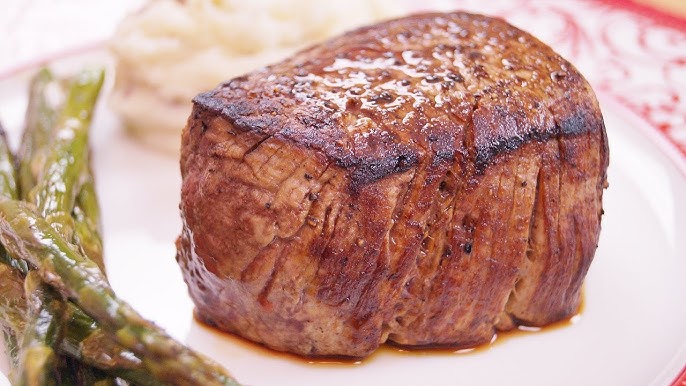Beef Filet Mignon Recipe: Filet mignon isn’t just a fancy name you see on a steakhouse menu—it’s the epitome of tender, melt-in-your-mouth beef. Taken from the small end of the tenderloin, this cut is renowned for its buttery texture and rich flavor. Unlike other cuts, filet mignon comes from a muscle that doesn’t do much work, which is exactly why it’s so tender. It’s the kind of steak that doesn’t need much to shine. A little salt, pepper, and good sear—and boom—you’ve got something special on your plate.
What makes filet mignon even more appealing is its versatility. Whether you’re celebrating a birthday, hosting a dinner party, or just treating yourself, filet mignon always feels like a step up. And don’t let the restaurant price tag fool you—you can make it at home with just a few basic tools and ingredients.
So why do people go crazy over filet mignon? Simple. It’s lean but still juicy, has a subtle beefy flavor that pairs perfectly with sauces, and most importantly—it cooks fast. Within 10–15 minutes, you can have a restaurant-quality dish right in your own kitchen. Sounds good, right? Keep reading, because we’re about to break it all down for you.
Why Cook Filet Mignon at Home?
Here’s the thing—ordering filet mignon at a steakhouse might set you back $50 or more. But when you cook it at home, not only do you save money, but you also control every detail of the cooking process. Prefer medium-rare? Want it seasoned with garlic and thyme? Need a dairy-free version? You’ve got full creative control.
Also, let’s be real: there’s something deeply satisfying about nailing the perfect sear yourself. You feel like a chef in your own kitchen, and you get to enjoy that steak in your pajamas if you want. No dress code required.
And if you’re worried it might be too difficult—don’t. With the right guidance (which you’re getting right here), cooking filet mignon at home is actually pretty easy. In fact, once you try it, you may never go back to the restaurant version again.
List of Ingredients You’ll Need
Core Ingredients
Here’s your shopping list for classic filet mignon:
- 2 Filet Mignon steaks (6–8 oz each, about 1.5–2 inches thick)
- Kosher salt
- Freshly ground black pepper
- High-heat oil (canola, avocado, or grapeseed oil)
- Unsalted butter
Optional Flavor Enhancers
Want to add depth and gourmet flair? Consider these:
- Fresh garlic cloves (smashed)
- Fresh thyme or rosemary
- Shallots (sliced)
- Dijon mustard (for post-cook brushing)
- Red wine (for pan sauce)
- Beef or chicken broth (for sauce)
Keep in mind—less is more. Filet mignon has a delicate flavor that shines on its own, so don’t overpower it. Salt, pepper, and butter alone can create magic.
Essential Tools for Cooking Filet Mignon
You don’t need a fancy kitchen, but these tools make a big difference:
- Cast iron skillet or heavy-bottomed stainless steel pan
- Tongs (never use a fork to flip steak!)
- Instant-read meat thermometer
- Oven (for finishing)
- Aluminum foil (for resting)
- Small saucepan (if making a sauce)
- Sharp knife and cutting board
These tools ensure consistent cooking, especially for beginners who want to nail the internal temperature just right. Trust me—it’s worth investing in a good meat thermometer.
Selecting the Perfect Filet Mignon
What to Look for at the Butcher
When shopping, look for steaks that are:
- Uniform in shape and thickness (1.5–2 inches is ideal)
- Bright red in color (not brown or grey)
- Marbled with thin streaks of fat (don’t worry, filet is naturally lean)
Avoid pre-packaged filet mignon from discount grocery stores. Go to a quality butcher if you can. The fresher, the better.
Prime vs. Choice vs. Grass-fed
- Prime: Best quality, most tender, and juicy—but also the most expensive.
- Choice: Still great, with slightly less marbling.
- Grass-fed: Leaner, more earthy in flavor, and considered healthier by many.
Choose what fits your taste and budget. Prime is amazing, but a well-cooked Choice filet can be just as delicious.
Preparing the Steak: Pre-Cooking Tips
This step is crucial and often skipped—don’t make that mistake.
- Bring to Room Temperature: Take the steaks out of the fridge 30–45 minutes before cooking. This helps them cook evenly.
- Pat Dry: Moisture is the enemy of a good sear. Use paper towels to pat the steaks completely dry.
- Season Generously: Use more salt and pepper than you think you need. Don’t worry—it won’t be salty. The crust it creates is pure flavor.
- Optional Prep: If using garlic and herbs, crush the garlic and set aside a few sprigs of fresh thyme or rosemary. You’ll toss these into the pan later.
Doing these simple things upfront makes all the difference. You’re setting the foundation for that Instagram-worthy crust.
How to Cook Filet Mignon: Step-by-Step
Step 1: Preheat Your Pan or Grill
Start by preheating a heavy skillet or grill to high heat. A cast-iron pan works best for a perfect sear. Make sure it’s smoking hot—this locks in the juices and creates that irresistible crust.
Step 2: Season the Filets Generously
Pat the steaks dry, then season both sides with coarse salt and freshly cracked black pepper. You can add a touch of garlic powder or rosemary, but simplicity is key to let the beef shine.
Step 3: Sear for the Perfect Crust
Add a bit of oil to the hot pan, then place your filets in carefully. Sear each side for 2–3 minutes until golden brown. Don’t move them too much—let the crust form naturally.
Step 4: Finish in the Oven (or Not!)
Transfer the pan to a preheated oven at 400°F (200°C) and cook for 4–6 minutes for medium-rare. Alternatively, reduce the stovetop heat and cook covered if you prefer to skip the oven.
Step 5: Let it Rest
Remove the steaks and let them rest on a cutting board for 5–10 minutes. This allows the juices to redistribute, keeping the meat tender and juicy. Serve with a knob of herb butter for that restaurant-level finish.
Preferred Cooking Methods
Pan-Seared and Oven-Finished (Most Reliable Method)
This is hands-down the most foolproof way to get filet mignon right every time. You start by searing it on a screaming hot cast iron skillet to get that beautiful crust, then finish it in the oven to bring the inside up to your desired doneness. Why is this method so reliable? Because searing alone won’t cook the center evenly without overcooking the outside. The oven gives you gentle, even heat to finish the job perfectly.
Here’s a recap:
- Sear: 2–3 minutes per side in a hot skillet.
- Finish in oven: 4–7 minutes at 400°F, depending on thickness and doneness.
Grilled Filet Mignon (For a Smoky Flavor)
If you’re a grill lover, you’ll appreciate the smoky, charred edges the grill brings to filet mignon. Make sure to oil the grates well and preheat to high. Sear each side for 3–4 minutes, then move to indirect heat and finish with the lid closed.
Pro tip: Don’t overdo the flame—filet mignon is lean and can dry out fast on direct flame.
Sous Vide (For the Perfectionist)
Sous vide gives you next-level control over doneness. Just vacuum-seal your filet mignon with butter, herbs, and garlic, then cook it in a water bath at your target temperature (e.g., 130°F for medium-rare) for 1–2 hours. After that, quickly sear in a hot pan for that crust.
It takes longer but guarantees perfect edge-to-edge pink every single time. Think of it as steak science.
How Long Should You Cook Filet Mignon?
Cooking Time by Thickness and Doneness
Cooking times will vary depending on the thickness of the filet and your desired doneness. Here’s a handy guide:
| Thickness | Rare (125°F) | Medium-Rare (130°F) | Medium (140°F) | Medium-Well (150°F) |
|---|---|---|---|---|
| 1 inch | 3 mins/side | 4 mins/side | 5 mins/side | 6 mins/side |
| 1.5 inch | 4 mins/side | 5 mins/side | 6 mins/side | 7 mins/side |
| 2 inches | 5 mins/side + oven finish | 6 mins/side + oven | 7 mins/side + oven | 8 mins/side + oven |
Always use an instant-read thermometer for best results.
Internal Temperature Guide
Stick the thermometer into the thickest part of the steak—not touching the pan—and use this temperature chart:
- Rare: 120–125°F
- Medium-Rare: 130–135°F
- Medium: 140–145°F
- Medium-Well: 150–155°F
- Well Done: 160°F+
Remember: remove the steak when it’s about 5°F below your target. It will continue cooking as it rests.
Making the Perfect Pan Sauce (Optional)
Filet mignon is amazing on its own, but a pan sauce? That’s where steak becomes gourmet.
Classic Red Wine Reduction
Ingredients:
- ½ cup red wine (Cabernet works great)
- ½ cup beef stock
- 1 tbsp minced shallots
- 1 tbsp butter
- Salt and pepper to taste
How to make it:
- After searing the steaks, remove them from the pan and reduce the heat.
- Add shallots and sauté until translucent.
- Deglaze with wine—scrape the brown bits from the pan.
- Add stock and simmer for 5–7 minutes until reduced by half.
- Whisk in butter for a glossy finish.
Creamy Peppercorn Sauce
Ingredients:
- ½ cup heavy cream
- 1 tbsp green peppercorns (crushed)
- 1 tbsp Dijon mustard
- 1 tbsp brandy (optional)
Combine and simmer for 5–10 minutes in the same skillet post-sear. The result is rich, tangy, and perfect with filet.
Serving Suggestions
Best Sides to Pair With Filet Mignon
Want to make your plate pop? Pair your filet with:
- Garlic mashed potatoes – Creamy and savory
- Grilled asparagus – Light and fresh
- Roasted Brussels sprouts – Earthy and slightly crispy
- Creamed spinach – Rich and decadent
- Buttered baby carrots – Adds color and sweetness
You can also add a crusty dinner roll or some truffle mac and cheese if you’re going all out.
Plating Tips for a Restaurant-Style Finish
- Use a white plate for contrast.
- Slice filet mignon into medallions and fan them out.
- Spoon sauce artfully around the steak, not over it.
- Garnish with a sprig of rosemary or a few microgreens.
- Add a drizzle of olive oil or balsamic reduction around the edges.
Presentation matters—make it Instagram-worthy!
Common Mistakes to Avoid
Even a high-quality steak can go south if you’re not careful. Avoid these slip-ups:
- Skipping the rest: Resting your steak is non-negotiable. It keeps juices in the meat—not on your plate.
- Under-seasoning: Don’t be shy with salt. Filet mignon is mild and needs seasoning.
- Overcooking: This cut is lean, so medium-well or well-done will make it dry and chewy.
- Not using a thermometer: Guesswork ruins good meat. Use a thermometer for consistent results.
- Starting with a cold pan: Always preheat. A cold pan equals a pale, soggy crust.
Avoid these, and you’re on your way to steak heaven.
Storing and Reheating Leftovers
Got leftovers? First of all—lucky you.
Storage:
- Wrap tightly in foil or place in an airtight container.
- Store in the fridge for up to 3 days.
Reheating:
- Best method: Place in a 250°F oven for 10–15 minutes, wrapped in foil.
- Avoid microwaving—it dries the meat.
- Want to revive the flavor? Add a pat of butter or spoon over any leftover sauce.
Leftover filet mignon also makes an amazing steak sandwich or salad topper.
Nutrition Facts and Serving Size
Here’s a rough estimate per 6 oz filet (without sauce or sides):
- Calories: 320
- Protein: 36g
- Fat: 20g
- Carbs: 0g
- Sodium: 70mg
Filet mignon is high in protein and relatively low in fat compared to ribeye or NY strip, making it a leaner option for steak lovers. Plus, it’s naturally carb-free and gluten-free—win-win!
FAQs about Beef Filet Mignon Recipe
1. Can I cook filet mignon without a cast iron skillet?
Yes, you can use any heavy-bottomed skillet that retains heat well. Stainless steel works great—just make sure it’s oven-safe if you plan to finish in the oven.
2. What wine pairs best with filet mignon?
A full-bodied red like Cabernet Sauvignon, Merlot, or Malbec pairs beautifully. The tender meat and rich wine create the ultimate flavor combo.
3. Is filet mignon healthy?
Compared to fattier cuts, filet mignon is relatively lean, high in protein, and low in carbs. It’s a great option for low-carb, keto, or high-protein diets.
4. Can I marinate filet mignon?
You can, but it’s not necessary. This cut is already tender and flavorful. If you do marinate, keep it simple—olive oil, garlic, and herbs are all you need.
5. How do I make filet mignon more flavorful?
Try basting with butter, garlic, and fresh herbs during cooking. You can also add a crust with crushed peppercorns or top with a bold sauce like red wine reduction or blue cheese butter.
Conclusion
Filet mignon may have a fancy reputation, but making it at home is surprisingly simple. All you need is a quality cut of beef, a hot pan, a few key ingredients, and the confidence to follow through. With this step-by-step guide, you now have everything you need to serve up a restaurant-quality filet mignon without leaving your kitchen.
Whether you’re planning a romantic dinner, a celebration, or just spoiling yourself on a Tuesday night—you deserve the best. So light that candle, pour a glass of wine, and enjoy every bite. You’ve earned it.



